|
 |
| Adult, Del Norte County |
 |
 |
 |
| Adult, Humboldt County |
Adult, Del Norte County |
 |
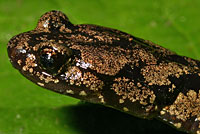 |
 |
| Adult, Del Norte County |
Adult, Del Norte County |
Adult, Mendocino County.
© Mike Spencer |
 |
 |
 |
| Underside of adult, Del Norte County |
Adult, Humboldt County.
© Mark Gary |
Adult in situ crawling on the wall of a building about 2 meters off the ground, Humboldt County © Noah Morales |
 |
 |
 |
Three variations of adult Wandering Salamanders from Del Norte County:
black on the left, brown in the center, and gold on the right. © Alan Barron |
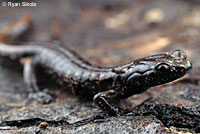 |
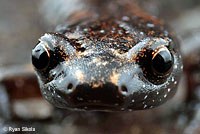 |
 |
| Adult, Mendocino County © Ryan Sikola |
 |
 |
 |
Adult, Del Norte County
© Alan Barron |
Underside of adult, Del Norte County
© Alan Barron |
Adult male, showing the mental gland under his chin, Humboldt County
© Spencer Riffle |
| |
 |
|
| |
The Wandering Salamander has toes with squared-off tips. Compare with the more rounded toe tips of Aneides flavipunctatus, the Black Salamander. |
|
| |
|
|
| Juveniles |
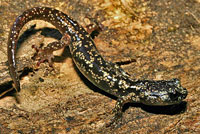 |
 |
 |
| Sub-adult, Humboldt County |
Sub-adult, Humboldt County |
Sub-adult, Humboldt County |
 |
 |
 |
| Sub-adult, Mendocino County |
Sub-adult, Humboldt County |
 |
 |
 |
| Sub-adult, Humboldt County. This salamander was found under a rock at the edge of a creek in early summer when the surrounding redwood forest was very dry. |
Juvenile, Del Norte County |
 |
 |
 |
Dark juvenile, Del Norte County
© Alan Barron |
Juvenile, Del Norte County
© Alan Barron |
Underside of juvenile, Del Norte County (lying on snow during one of the rare snow events in the redwoods.)
© Alan Barron |
 |
 |
 |
Sub-adult in situ on a log where it was observed at night several times in 3 weeks, Humboldt County
© Spencer Riffle |
Juvenile, Del Norte County
© Alan Barron |
Juveniles in situ in their refuge - a crack in a log - where they were observed regularly over four weeks, Humboldt County © Spencer Riffle |
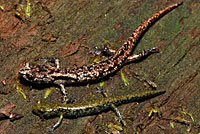 |
 |
 |
| Juvenile, Humboldt County, on top, with a juvenile Speckled Black Salamander from the same location for comparison, on the bottom. |
Juvenile, Sonoma County © Andre Giraldi |
|
|
|
Below is a series of pictures all © Spencer Riffle showing a female Wandering Salamander in Humboldt County brooding her eggs over a period of just over three months, when the eggs hatch and we can see the tiny hatchlings. Click Here to see a larger view. |
 |
 |
 |
| Female with eggs - 7/9 |
Female with eggs - 7/10 |
Female with eggs - 7/16 |
 |
 |
 |
| Female with eggs - 9/2 |
Female with eggs - 9/2 |
Female with eggs - 9/25 |
| |
 |
|
| |
Female with hatchlings - 10/14 |
|
| |
|
|
| Habitat |
 |
 |
 |
| Habitat, Mendocino County |
Habitat, Del Norte County |
Habitat, Mendocino County |
 |
 |
 |
Redwood forest habitat,
Humboldt County |
Wandering Salamanders inhabit the canopies of
massive redwood trees such as these. |
 |
 |
|
| Habitat, Humboldt County |
Habitat, Humboldt County |
|
| |
|
|
| Short Videos |
 |
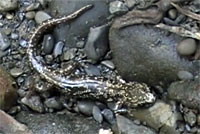 |
|
| A couple of Wandering Salamanders discovered at the edge of a creek in the redwoods during a dry period in late June. |
Juvenile Wandering Salamanders found under creekside rocks in summer in the Humboldt County redwoods. |
|
|
|
|
| Description |
| |
| Size |
Adults are 1 4/5 - 3 inches long (4.6 - 7.6 cm) from snout to vent, 3 - 5 inches (7.5 -13 cm) in total length.
|
| Appearance |
A medium-sized salamander.
Slim, long-legged, adapted for climbing with long squared-off toes and rounded prehensile tail.
Usually 16 costal grooves.
Two nasolabial grooves.
|
| Color and Pattern |
| Dark brown, to pale gray ground color, clouded with greenish gray, pale gold, or reddish blotches scattered with brassy flecks. |
| Male / Female Differences |
| Males have broader, more triangular heads than females. |
| Young |
Young have a copper or brassy dorsal stripe.
|
| Life History and Behavior |
A member of family Plethodontidae, the Plethodontid or Lungless Salamanders.
Plethodontid salamanders do not breathe through lungs. They conduct respiration through their skin and the tissues lining their mouth. This requires them to live in damp environments on land and to move about on the ground only during times of high humidity. (Plethodontid salamanders native to California do not inhabit streams or bodies of water but they are capable of surviving for a short time if they fall into water.)
Plethodontid salamanders are also distinguished by their nasolabial grooves, which are vertical slits between the nostrils and upper lip that are lined with glands associated with chemoreception.
All Plethodontid Salamanders native to California lay eggs in moist places on land.
The young develop in the egg and hatch directly into a tiny terrestrial salamander with the same body form as an adult.
(They do not hatch in the water and begin their lives as tiny swimming larvae breathing through gills like some other types of salamanders.)
|
| Activity |
Active on wet nights.
One of the most arboreal salamanders in California, found up to 40 m. above ground.
Often forages from beneath bark or logs, sitting still, waiting for small invertebrate prey to come close. |
| Gliding and Parachuting |
A May 2022 paper by Brown et al ** published in Current Biology describes how A. vagrans jumps and glides from trees, based on studies using salamanders in a wind tunnel. Since they don't have any physical adaptations to control their descent such as wings or skin membranes that stretch for gliding, the salamanders adjust their limbs and tail and undulate their torso when gliding to allow them to slow their vertical speed up to ten percent, which is enough to avoid injury. In other words, they jump off a tree at an angle (they don't fall straight down) then move their body and limbs and tail around to slow their fall until they land safely farther down the tree. This is similar to observations of ants, spiders, and Green Anole lizards modulating their falls from trees.
You can watch a Deep Look YouTube video about this that shows a salamander gliding in a wind tunnel. |
| Blood-filled Toe Tips Help With Jumping and Landing |
Christian Brown et al, 2025, investigated the square-shaped toe tips of A. vagrans, and concluded that "...A. vagrans, and likely other climbing salamanders, can functionally fill, trap, and drain the blood in their vascularized toe tips to optimize attachment, detachment, and complex arboreal locomotion (e.g., landing after gliding flight). Such an adaptation could provide insights for bioinspired designs."
Christian E. Brown, William P. Goldenberg, Olivia M. Hinds, Mary Kate O'Donnell, and Nancy L. Staub. Vascular and Osteological Morphology of Expanded Digit Tips Suggests Specialization in the Wandering Salamander (Aneides vagrans) Journal of Morphology, 08 January 2025. |
| Territoriality |
| Wandering Salamanders do not appear to be as aggressive and territorial like A. ferreus, and they do not use chemical signals in their fecal pellets to mark their territories. |
| Defense |
| Defense tactics include crawling away quickly, remaining motionless, raising up on the legs and waving the tail, and making fast jerky motions, then remaining still. |
| Diet and Feeding |
| A generalist feeder, consuming a variety of small invertebrates, including ants, mites, beetles, and isopods. Juveniles eat small prey items at first, with the size of prey increasing as the juveniles grow larger. |
| Reproduction |
Reproduction is terrestrial.
Breeding males have a well-developed mental gland.
Males appear to be sexually mature in their second year, females in their third year. |
| Eggs |
Females lay from 6 - 9 eggs in moist places on land in spring and early summer.
Eggs have been found under the bark of a rotting Douglas fir log and at the base of a tree limb high up a tree.
Females probably stay with the eggs until they hatch. |
| Young |
Young develop completely in the egg and hatch fully formed.
Juveniles are likely to prefer bark litter over rock or leaf litter.
|
| Habitat |
Occurs in coastal forests of Douglas fir, cedar, alder, and redwood, often at borders of clearings. Found under bark of standing or fallen dead trees, inside rotten logs, under loose bark on the ground, under rocks, in crevices in cliffs, and high up in forest canopy. Characteristically associated with large logs and talus. Often abundant in recently burned or logged areas having numerous stumps and large amounts of woody debris, and in areas where rock faces or talus provide deep cracks. Where its range overlaps with A. ferreus, A. vagrans is less likely to be found sheltering under rocks or on rocky slopes than A. ferreus.
Inhabiting Old-growth Redwood Tree Crowns
In a 2006 paper, Spickler, et al * report a mark and capture study of Wandering Salamanders in 5 massive old-growth redwood trees each standing over 90 meters high (295 ft.) in Prairie Creek Redwoods State Park. They found that each tree was inhabited by up to 29 salamanders which inhabit crevices, cavities, woody debris lodged into parts of the tree, and mats of soil and epiphytic ferns that absorb moisture like a sponge. They speculate that the shelter and moisture provided by these microhabitats found high in the redwood canopy enable year-round occupation of the canopy by the salamanders. (Surveys were not possible during the spring and summer months.) They found no evidence that the salamanders were moving between trees or onto the ground and suggest that the salamanders breed and potentially live their entire lives within the tree crowns.
|
| Geographical Range |
Endemic to California, but introduced onto Vancouver Island and on neighboring islands and a small area of mainland British Columbia. Occurs along the coast from northwest Sonoma County near Stewart's Point to the Smith River northern Del Norte County.
Populations inhabiting most of Vancouver Island, B.C., were probably introduced from California in shipments of Tan Oak bark in the late 19th century.
|
 |
| Elevational Range |
From near sea level to 5,400 ft. (1,700 m.)
|
| Notes on Taxonomy |
In a 1987 paper Sessions and Kezer were the first to provide evidence that Aneides ferreus was composed of two chromosomally distinct species, later described as A. ferreus and A. vagrans.
(Sessions and Kezer (1987) Cytogenetic evolution in the plethodontid salamander genus Aneides. Chromosoma 95:17-30)
Based on biochemical analysis, Aneides ferreus was split into two species - A. ferreus and A. vagrans, which are similar in appearance and behavior.
(Wake, David and Jackman, Todd - Description of a new species of plethodontid salamander from California
Canadian Journal of Zoology Vol. 76, 1998)
Old sources show the range of A. ferreus to continue all the way south to northwest Sonoma County, but populations in California south of extreme northwest Del Norte County that were previously labelled as A. ferreus are now known to be a separate species, Aneides vagrans - Wandering Salamander.
Alternate and Previous Names (Synonyms)
Aneides vagrans - Wandering Salamander (Wake & Jackman 1998, Stebbins 2003, 2012)
Aneides ferreus - Clouded Salamander (Stebbins 1954, 1966, 1985)
Aneides ferreus - Clouded Salamander (Rusty Salamander) (Bishop 1943(
Aneides ferreus - Rusty Salamander (Storer 1925)
Aneides ferreus - Rusty Salamander (Grinnell and Camp 1917)
Autodax ferreus (Van Denburgh 1916)
Anaides ferreus (Cope 1869)
|
| Conservation Issues (Conservation Status) |
| Although populations have been lost due to logging practices and urban development, this salamander appears to thrive in regenerating forest. This species actually has a wider current distribution than historical distribution due to their introduction in British Columbia. |
|
| Taxonomy |
| Family |
Plethodontidae |
Lungless Salamanders |
Gray, 1850 |
| Genus |
Aneides |
Climbing Salamanders |
Baird, 1851 |
Species
|
vagrans |
Wandering Salamander |
Wake and Jackman, 1999 |
|
Original Description |
Wake, David and Jackman, Todd - Description of a new species of plethodontid salamander from California
Canadian Journal of Zoology Vol. 76, 1998
|
|
Meaning of the Scientific Name |
Aneides - Greek = lacking form or shape
vagrans - Latin = wandering
from Scientific and Common Names of the Reptiles and Amphibians of North America - Explained © Ellin Beltz
|
|
Related or Similar California Salamanders |
Aneides ferreus - Clouded Salamander
Aneides flavipunctatus - Speckled Black Salamander
Aneides iecanus - Shasta Black Salamander
Aneides klamathensis - Klamath Black Salamander
Aneides lugubris - Arboreal Salamander
Aneides niger - Santa Cruz Black Salamander
|
|
More Information and References |
California Department of Fish and Wildlife
AmphibiaWeb
Hansen, Robert W. and Shedd, Jackson D. California Amphibians and Reptiles. (Princeton Field Guides.) Princeton University Press, 2025.
Stebbins, Robert C., and McGinnis, Samuel M. Field Guide to Amphibians and Reptiles of California: Revised Edition (California Natural History Guides) University of California Press, 2012.
Stebbins, Robert C. California Amphibians and Reptiles. The University of California Press, 1972.
Flaxington, William C. Amphibians and Reptiles of California: Field Observations, Distribution, and Natural History. Fieldnotes Press, Anaheim, California, 2021.
Nicholson, K. E. (ed.). 2025. Scientific and Standard English Names of Amphibians and Reptiles of North America North of Mexico, with Comments Regarding Confidence in Our Understanding. Ninth Edition. Society for the Study of Amphibians and Reptiles. [SSAR] 87pp.
Samuel M. McGinnis and Robert C. Stebbins. Peterson Field Guide to Western Reptiles & Amphibians. 4th Edition. Houghton Mifflin Harcourt Publishing Company, 2018.
Stebbins, Robert C. A Field Guide to Western Reptiles and Amphibians. 3rd Edition. Houghton Mifflin Company, 2003.
Behler, John L., and F. Wayne King. The Audubon Society Field Guide to North American Reptiles and Amphibians. Alfred A. Knopf, 1992.
Robert Powell, Roger Conant, and Joseph T. Collins. Peterson Field Guide to Reptiles and Amphibians of Eastern and Central North America. Fourth Edition. Houghton Mifflin Harcourt, 2016.
Powell, Robert., Joseph T. Collins, and Errol D. Hooper Jr. A Key to Amphibians and Reptiles of the Continental United States and Canada. The University Press of Kansas, 1998.
American Museum of Natural History - Amphibian Species of the World 6.2
Bartlett, R. D. & Patricia P. Bartlett. Guide and Reference to the Amphibians of Western North America (North of Mexico) and Hawaii. University Press of Florida, 2009.
Bishop, Sherman C. Handbook of Salamanders. Cornell University Press, 1943.
Lannoo, Michael (Editor). Amphibian Declines: The Conservation Status of United States Species. University of California Press, June 2005.
Petranka, James W. Salamanders of the United States and Canada. Smithsonian Institution, 1998.
Jones, Lawrence L. C. , William P. Leonard, Deanna H. Olson, editors. Amphibians of the Pacific Northwest. Seattle Audubon Society, 2005.
* Spickler, James C., Stephen C. Sillett, Sharyn B. Marks, and Hartwell H. Welsh, Jr.
Evidence of a New Niche for a North American Salamander: Aneides vagrans Residing in the Canopy of Old-growth Redwood Forest. Herpetological Conservation and Biology 1(1):16-27 Submitted: June 15, 2006; Accepted: July 19, 2006
Joseph Grinnell and Charles Lewis Camp. A Distributional List of the Amphibians and Reptiles of California. University of California Publications in Zoology Vol. 17, No. 10, pp. 127-208. July 11, 1917.
** Christian E. Brown, Erik A. Sathe, Robert Dudley, and Stephen M. Deban. Gliding and Parachuting by Arboreal Salamanders. Current Biology, Volume 32, Issue 10, R441–R456 May 23, 2022.
|
|
|
The following conservation status listings for this animal are taken from the July 2025 State of California Special Animals List and the July 2025 Federally Listed Endangered and Threatened Animals of California list (unless indicated otherwise below.) Both lists are produced by multiple agencies every year, and sometimes more than once per year, so the conservation status listing information found below might not be from the most recent lists, but they don't change a great deal from year to year.. To make sure you are seeing the most recent listings, go to this California Department of Fish and Wildlife web page where you can search for and download both lists:
https://www.wildlife.ca.gov/Data/CNDDB/Plants-and-Animals.
A detailed explanation of the meaning of the status listing symbols can be found at the beginning of the two lists. For quick reference, I have included them on my Special Status Information page.
If no status is listed here, the animal is not included on either list. This most likely indicates that there are no serious conservation concerns for the animal. To find out more about an animal's status you can also go to the NatureServe and IUCN websites to check their rankings.
Check the current California Department of Fish and Wildlife sport fishing regulations to find out if this animal can be legally pursued and handled or collected with possession of a current fishing license. You can also look at the summary of the sport fishing regulations as they apply only to reptiles and amphibians that has been made for this website.
This salamander is not included on the Special Animals List, meaning there are no significant conservation concerns for it in California according to the California Department of Fish and Game.
|
| Organization |
Status Listing |
Notes |
| NatureServe Global Ranking |
|
|
| NatureServe State Ranking |
|
|
| U.S. Endangered Species Act (ESA) |
None |
|
| California Endangered Species Act (CESA) |
None |
|
| California Department of Fish and Wildlife |
None |
|
| Bureau of Land Management |
None |
|
| USDA Forest Service |
None |
|
| IUCN |
|
|
|
|
|


























































